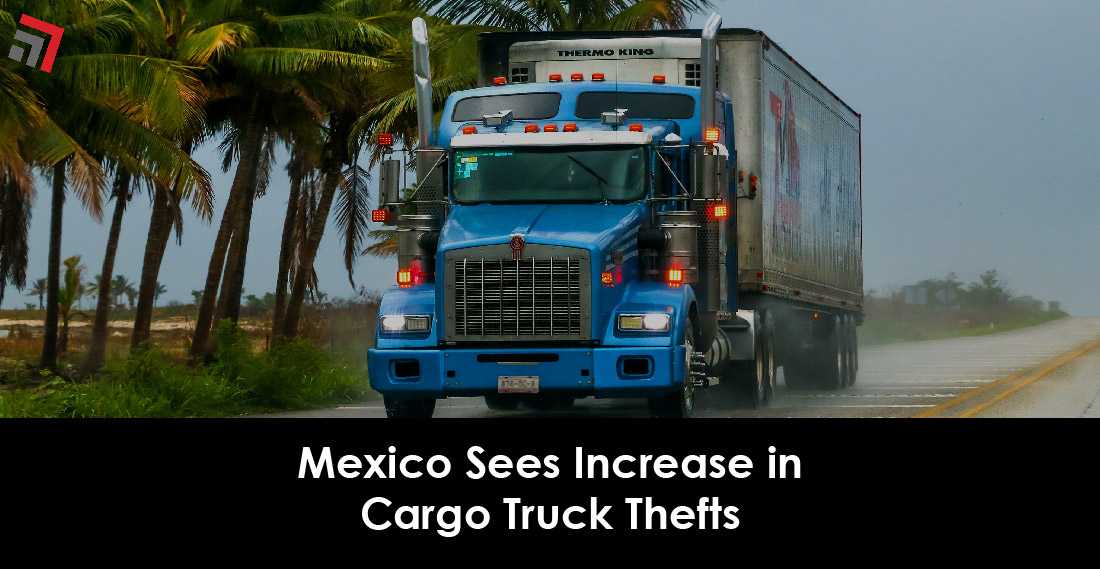For North American supply chains, an unstoppable force—untapped growth in cross-border trade—has met an unmovable object—a rampant rise in cargo truck thefts.
In April, 153 incidents of cargo truck thefts were reported across Mexico’s roadways, according to the National Association of Vehicle Tracking and Protection Companies (ANERPV), a Mexico-based vehicle security and tracking organization. The total number of incidents is a 7.7 percent increase from April 2023 and translates to about five truck thefts per day over the last month.
Since January, ANERPV has reported a total of 546 cargo truck thefts, a 5 percent year-over-year increase. Of Mexico’s 31 states, its state of Mexico had the highest number of thefts (138), followed by Puebla (131), Hidalgo (43), Guanajuato (41), and Jalisco (38). About one third of the country’s thefts this year occurred in the early morning, while more than a quarter took place during the afternoon and early evening.
In a press release, the Mexican Association of Insurance Institutions (AMIS), another Mexico-based organization that monitors cargo theft, stated that the theft of heavy-duty trucks is strongly correlated with the theft of the cargo onboard. In other words, thieves target vehicles while in transit, not only stealing the carrier’s equipment, but also the stowed goods of the shipper in the trailer.
AMIS added that dry van trailers are the most frequently targeted trailer type, while food/beverages, household items, and electronics are the most targeted cargoes.
Mexico’s theft issue poses grave danger for truck drivers
Perhaps the most unsettling takeaway from Mexico’s rampant rise in theft is how these malignant acts are perpetrated. As the times when they most occur signal, these incidents are not usually clandestine plots executed in the middle of the night when a truck is idling or parked. Rather, they are more likely to happen in broad daylight, suggesting a more forceful approach from thieves.
AMIS reported that nearly three quarters of incidents in the country involve some form of violence.
Instead of digital fraud, like double brokering or fictious pickups, thieves in Mexico are more open to exerting brute-force techniques to steal trucks and trailers. Unlike the U.S., where, albeit, cargo theft is also soaring, Mexico’s theft problem extends beyond losses in money and reputation. The country’s professional truck drivers are in direct risk of bodily harm and, in some cases, even death.
Mexico’s National Chamber of Cargo Transportation (CANACAR) reported that at least 50 truck drivers have been killed on the country’s roadways by cargo thieves since 2023. The risks of violence are highest in central Mexico on roadways between Puebla, Mexico City, and Zacatecas.
The issue has rightly concerned Mexico’s truck drivers who, on behalf of CANACAR, which represents 500,000 of the country’s drivers, sent a letter to Mexico’s president, demanding more military patrols on roadways and stricter penalties against assailants.
However in February, after a lack of government initiative, truck drivers resorted to a series of nationwide strikes, blockading several large highways across Mexico, including the border crossing between Juarez and El Paso, Texas.
Final Thoughts
Unfortunately, cargo truck theft, and subsequent safety issues, remain haunting Mexico’s roadways, thrusting a great degree of uncertainty for North American supply chains.
In 2023, Mexico was the top trading partner of the U.S., totaling over $6.7 billion—a 16 percent share of overall U.S. international trade. There is untapped potential for the commercial success between these two countries as more and more U.S. companies relocate manufacturing and sourcing operations south of the border.
However, if issues, like driver safety and rampant theft, are allowed to foment unmitigated, cross-border trade stakeholders, whether that is a Mexican driver from Sinaloa or an American logistics coordinator in Joplin, will bear a degree of risk. In the case for Mexico’s truck drivers, that risk entails a lot more.
Contact one of our team members if you have any questions regarding this topic or any others in cross-border logistics.
More blogs similar to this:



Recent Comments